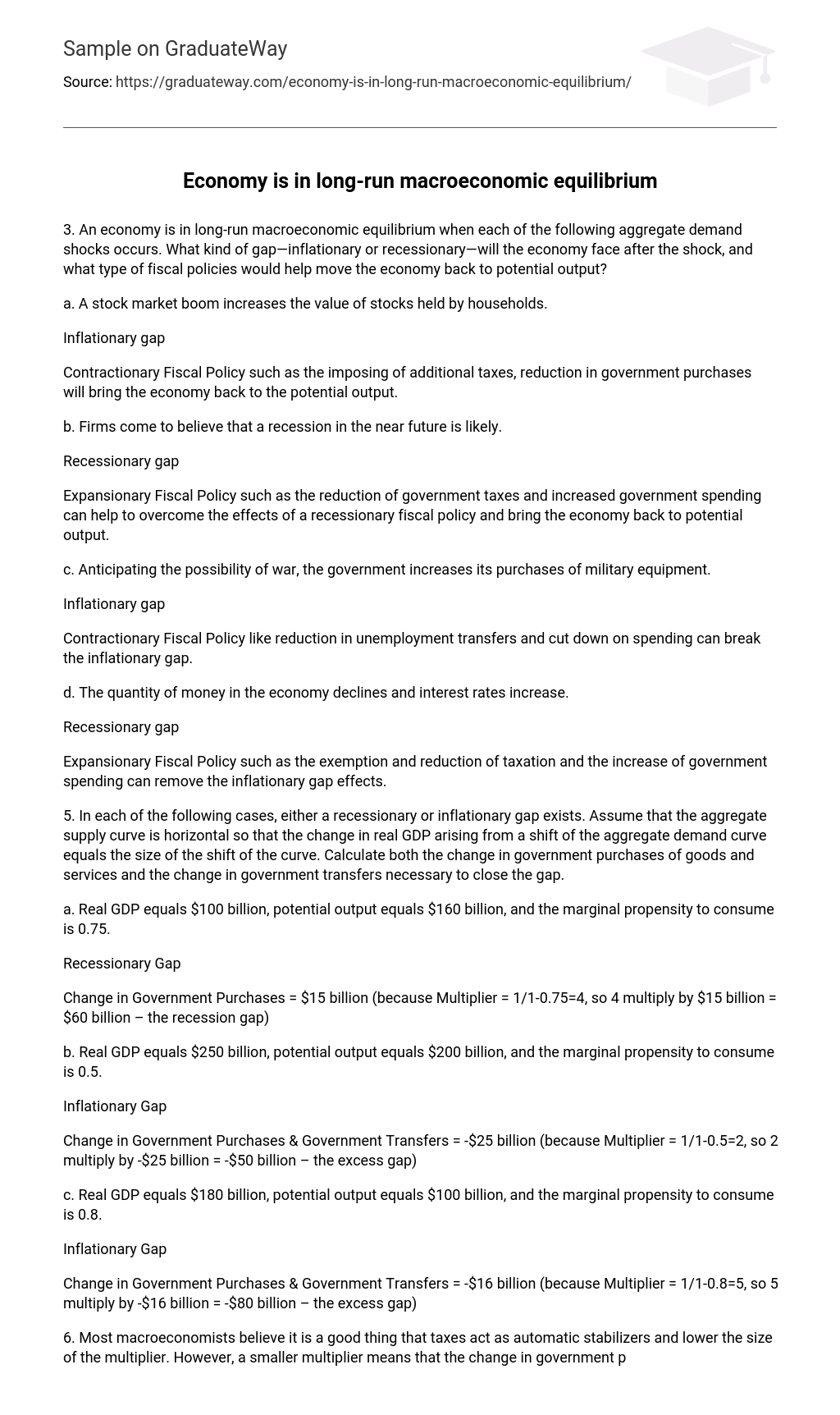3. An economy is in long-run macroeconomic equilibrium when each of the following aggregate demand shocks occurs. What kind of gap—inflationary or recessionary—will the economy face after the shock, and what type of fiscal policies would help move the economy back to potential output?
a. A stock market boom increases the value of stocks held by households.
Inflationary gap
Contractionary Fiscal Policy such as the imposing of additional taxes, reduction in government purchases will bring the economy back to the potential output.
b. Firms come to believe that a recession in the near future is likely.
Recessionary gap
Expansionary Fiscal Policy such as the reduction of government taxes and increased government spending can help to overcome the effects of a recessionary fiscal policy and bring the economy back to potential output.
c. Anticipating the possibility of war, the government increases its purchases of military equipment.
Inflationary gap
Contractionary Fiscal Policy like reduction in unemployment transfers and cut down on spending can break the inflationary gap.
d. The quantity of money in the economy declines and interest rates increase.
Recessionary gap
Expansionary Fiscal Policy such as the exemption and reduction of taxation and the increase of government spending can remove the inflationary gap effects.
5. In each of the following cases, either a recessionary or inflationary gap exists. Assume that the aggregate supply curve is horizontal so that the change in real GDP arising from a shift of the aggregate demand curve equals the size of the shift of the curve. Calculate both the change in government purchases of goods and services and the change in government transfers necessary to close the gap.
a. Real GDP equals $100 billion, potential output equals $160 billion, and the marginal propensity to consume is 0.75.
Recessionary Gap
Change in Government Purchases = $15 billion (because Multiplier = 1/1-0.75=4, so 4 multiply by $15 billion = $60 billion – the recession gap)
b. Real GDP equals $250 billion, potential output equals $200 billion, and the marginal propensity to consume is 0.5.
Inflationary Gap
Change in Government Purchases & Government Transfers = -$25 billion (because Multiplier = 1/1-0.5=2, so 2 multiply by -$25 billion = -$50 billion – the excess gap)
c. Real GDP equals $180 billion, potential output equals $100 billion, and the marginal propensity to consume is 0.8.
Inflationary Gap
Change in Government Purchases & Government Transfers = -$16 billion (because Multiplier = 1/1-0.8=5, so 5 multiply by -$16 billion = -$80 billion – the excess gap)
6. Most macroeconomists believe it is a good thing that taxes act as automatic stabilizers and lower the size of the multiplier. However, a smaller multiplier means that the change in government purchases of goods and services, government transfers, or taxes necessary to close an inflationary or recessionary gap is larger. How can you explain this apparent inconsistency?
Obviously this can be explained by the fact that the multiplier is the multi-effect creator in the GDP when there are changes in the spending or taxes. A large multiplier means that a small change in spending or taxes will rebound strongly, since the multiplier is the indicator of a chain reaction within the economy. Taxes act as automatic stabilizers since during a recessionary period, the public moves down in the tax brackets, and in a boom, moves up in the tax brackets. This automatically stabilizes any recession or expansion to a limit. But this also lowers the multiplier, so that it becomes difficult to easily change the recessionary or inflationary effects of the economy. This inconsistency springs from the fact, that people’s income brackets change according to their wages and in good times, they pay more tax and vice versa. So in good times, a lesser tax means a higher percentage spent on consumption and a higher tax means a lesser percentage on consumption, thus lowering the multiplier.
13. In which of the following cases does the size of the government’s debt and the size of the budget deficit indicate potential problems for the economy?
a. The government’s debt is relatively low, but the government is running a large budget deficit as it builds a highspeed rail system to connect the major cities of the nation.
Neither the debt nor the deficits (since it will pay back through trade) do not pose any potential problems for the economy.
b. The government’s debt is relatively high due to a recently ended deficit-financed war, but the government is now running only a small budget deficit.
The debt might propose a problem to the economy. The small budget deficit might help to overcome the threat posed by the debt in the run.
c. The government’s debt is relatively low, but the government is running a budget deficit to finance the interest payments on the debt.
Both the debt and the deficit pose a potential problem for the economy.
BIBLIOGRAPHY
Brue, McConnall (1989). MacroEconomics. NY: Krugman Wells





